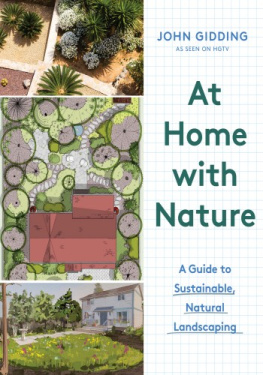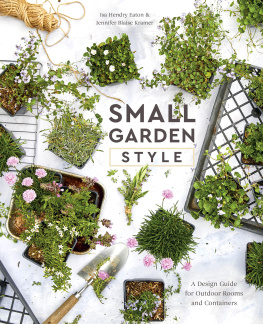The AMERICAN MEADOW GARDEN

The AMERICAN MEADOW GARDEN
Creating a Natural Alternative to the Traditional Lawn
JOHN GREENLEE
Photography by SAXON HOLT

Copyright 2009 by John Greenlee. All rights reserved.
Photographs copyright 2009 by Saxon Holt.
Published in 2009 by Timber Press, Inc.
The Haseltine Building | 2 The Quadrant |
133 S.W. Second Avenue, Suite 450 | 135 Salusbury Road |
Portland, Oregon 97204-3527 | London NW6 6RJ |
www.timberpress.com | www.timberpress.co.uk |
Printed in China
Second printing 2010
Library of Congress Cataloging-in-Publication Data
Greenlee, John.
The American meadow garden : creating a natural alternative to the traditional lawn / John Greenlee ; photography by Saxon Holt. 1st ed.
p. cm.
Includes bibliographical references and index.
ISBN 978-0-88192-871-6
1. Meadow gardeningUnited States. 2. GrassesUnited States. 3. Natural landscapingUnited States. I. Holt, Saxon. II. Title.
SB439.G737 2009
635.9'64dc22 2009019438
A catalog record for this book is also available from the British Library.

CONTENTS

This was my first meadow garden. it was an urban southern california oasisyoud never know you were surrounded by concrete and three million people.
PREFACE
WHY CREATE MEADOWS? For me, the reasons are many. Meadows are far more satisfying than either a lawn or traditional border, combining the best attributes of both: like a lawn, a calming place for the eye to rest, yet with the richness and complexity of a border. Unlike lawns, meadows are better for the environment, a safe habitat for beneficial insects and pollinators, a place where native ecology can thrive. Meadows, by attracting a diversity of life, are animated, alive with rhythmic movement, catching both wind and light. No lawn can do that. Andproperly designedmeadows require less maintenance and consume significantly less resources than lawn or border.
I hope this book explains my passion for meadows and persuades readers to make meadow gardens of their own. I cannot tell you when, exactly, in my adult life I became aware of my love for meadows; I can tell you that my love for these special spaces continues as strong as ever. You see, Ive been growing grasses as a nurseryman for more than two decades, yet it seems like only yesterday that my affair with them began. I say affair because a meadow is like a seductive mistress. Grasses are sensual. You can smell them, and hear them, and watch them move. Meadows are sexy, just like loversthey never stop changing, never ceasing to surprise. My love affair with meadows has become my lifes work. Now I make meadow gardens for a living.

Kurt Bluemels poolside garden. Kurt was a great inspiration to mehe really got the grass movement going in America.
Looking at where I grew upthe most sterile, natureless surroundings you could imagineyou might wonder how I ever wound up being called the Grass Guru. Our house was a 60s cookie-cutter tract home in Fullerton, CaliforniaOrange County before it was the O.C. In those days, developers were busy building Everymans vision of the American Dream. They couldnt cut down orange groves fast enough. Each L-shaped house had its own patch of lawn and a lollipop tree newly planted in the front. This was before planned communities, with few parks and no real nature, at least from a kids standpoint, as far as the eye could see. No tree was taller than an 8-foot stake, and no leaf ever turned a fall color that matched our third-grade reader. Remember your winding childhood creek? Ours was turned into a straight concrete storm drain. Our natural streams were literally paved into gutters.
But. On the edge of the development, on a phase not yet built, was what we called The Field. It was our favorite play spot: there the street ended, and the gutter just spilled water out, making what seemed like a natural stream cutting through a seasonal meadow of grass. The field was bordered by a row of big old eucalyptus trees, a classic California windbreak for the remaining citrus groves. They made that field seem a thousand miles away from the new houses they hid. Some scientists say that we humans all have The Savannah Syndrome, a DNA chip passed on by our African ancestors, who began on the savannahs, that draws us to the grasslands. But I think our instinctive love of grass happens when, as a child, youre just as tall as the grass. Ill never forget being flat on my back in that field, almost hypnotised by the swaying back and forth of grasses and staring at the clouds moving overhead. The wind, noisy in the eucalyptus trees and whispering in the grasses, is a song that still plays in my head. Late afternoons, catching the light, the grasses just seemed to glow. In the rainy season, we could pull up clumps of grass with small chunks of moist earth and lob them at each other. My brothers and I would play hide and seek, make trails and forts, and just enjoy being in the tall grass. I also remember the meadowlarks, and that indescribable liquid trill they make. You only find meadowlarks where you find grass; they make their nests on the ground, in the grass. I stumbled upon their sky-blue speckled eggs and wondered, why were they there? In that field, I think, is where meadows got under my skin.
The first real nature I encountered came through summers spent at our Boy Scout Camp in the nearby San Bernardino Mountains. My favorite hike ended at a meadow opening in a Jeffrey pine forest. Jeffrey pines smell like vanilla on a hot summers day, and I vividly recall sitting there, out of sight in an old tree stump, watching hummingbirds fight over the nectar of the native scarlet columbines and purple penstemons that were sprinkled throughout this golden, scented meadow. Id watch their acrobatics until it was time to head back to camp.
At summers end it was back down the mountain to the smoggy suburbs below. I cut lawns on Saturdays and after school, and pulled weeds in peoples yards for money. I hated lawn mowersfor some reason, I never learned to love machines. Id rather have been in that mountain meadow than chopping nature into oblivion. Half the weeds I pulled looked prettier than the gardens around them.
The first Earth Day ever was during my senior year of high school. The environmental movement was just beginning, and my ecological awareness was beginning to clash with my declared college majorornamental horticulture, at Cal Poly, Pomona. Most of my friends were majoring in turf grass management, but turf grass and I just never hit it off. To me, turf management classes seemed to be about controlling nature, a better living through chemistry approachas if horticulture spelled danger and always required protective gear. But from where I stood, horticulture opened me up to the amazing world of plants.
Next page










